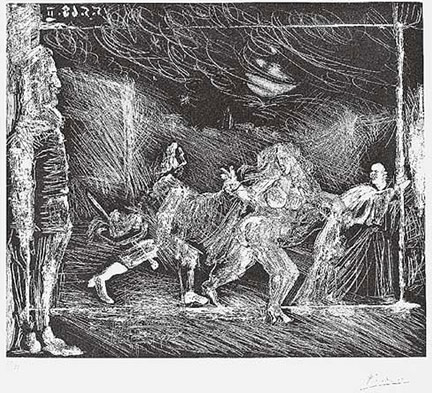 This original
aquatint and drypoint, Théâtre
ou Télévision:
cape et Épée,
1968 is
plate 87 from the 347
Series. This etching was
signed by Picasso and numbered from the edition of 50.
This original
aquatint and drypoint, Théâtre
ou Télévision:
cape et Épée,
1968 is
plate 87 from the 347
Series. This etching was
signed by Picasso and numbered from the edition of 50.
Between March 16 and October 5, 1968, Picasso created 347 etchings and
aquatints (some days completing 2 or 3 etching plates), an astonishing
outpouring of energy when Picasso was 86 years old. The series
began shortly after the
death of his companion and friend, Catalan poet Jaime Sabartés
(1881-1968). Picasso dedicated
a set of proofs in his memory.
In this large group of images Picasso references earlier subjects such
as French writer Honoré Balzac (1799-1850) , Rembrandt
(1606-1669), El Greco (1541-1614) and also his family -- parents, wives
and mistresses -- who often appear as performers, sometimes set in
circus scenes.
This
image appears to be a portrayal of the cloak and dagger films and
productions based on the writing of Alexandre Dumas (1802-1870).
With irony and ribald humor Picasso reviewed his life in this series,
his failing powers and his place in history. In fact, Picasso is
often observed in many of the 347
Series images as voyeur in these
images of fantasy and imagination.
The 347 Series
was printed in collaboration with brothers Piero (1934-2001) and Aldo
Crommelynck who, in 1963, set up a studio in Mougins when Picasso was
82 years old. Picasso's prolific production relied on the
absolute trust he had between himself and the master
engravers. The series was exhibited and published by the Galerie Louise Leiris
(Paris) in late 1968 and 1969. The etchings were not given titles
by Picasso as the artist usually had no use for them.
This
etching is
an excellent example of Picasso's mixed media graphics. In this
case
a combination of the tonal quality achieved by aquatint and the linear
detail of drypoint.
 This original
aquatint and drypoint,
This original
aquatint and drypoint,  This original
aquatint and drypoint, Théâtre
ou Télévision:
cape et Épée,
1968 is
plate 87 from the 347
Series. This etching was
signed by Picasso and numbered from the edition of 50.
This original
aquatint and drypoint, Théâtre
ou Télévision:
cape et Épée,
1968 is
plate 87 from the 347
Series. This etching was
signed by Picasso and numbered from the edition of 50.